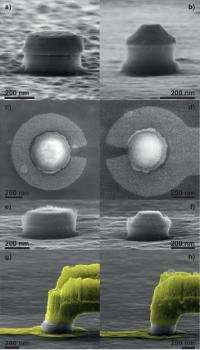September 19, 2012 feature
Scientists develop method for fabricating individual magnetic quantum dots

(Phys.org)—Quantum dots are semiconductor crystals that contain a few hundred atoms constrained into such a small space they're considered zero-dimensional objects, often called "artificial atoms." Researchers have fabricated quantum dots made of various materials and sizes. Now in a new study, scientists have demonstrated how to fabricate individual magnetic quantum dots with pillar diameters as low as 250 nm, the smallest dot of this type reported to date.
The researchers, led by Charles Gould, a postdoctoral researcher at the University of Würzburg, have published their study on the fabrication of magnetic quantum dots in a recent issue of Nanotechnology.
"These are not the first magnetic quantum dots, as magnetic quantum dots have previously been made by techniques such as self-assembly," Gould told Phys.org. "These previous techniques allow one to study a collection of many millions of quantum dots at a time, but do not allow for the study of individual dots. As such, since all the dots in the collection are slightly different, it is essentially impossible to extract properties of the individual dots. Our method, for the first time, allows the production and study of an individual magnetic artificial atom."
As the researchers explain, quantum dots commonly have one of two geometries: lateral (defined by two gates place side by side) or vertical (formed from a pillar in a quantum well). While it's unclear how to make a lateral quantum dot magnetic, a vertical dot can theoretically be made magnetic by doping the quantum well with manganese to give it magnetic properties. However, in reality this idea faces several technical challenges, such as the need for deep trenches, an insulating coating on the pillar, and precise alignment of the components.
In this study, the researchers have overcome these fabrication challenges by developing a multi-step process that uses electron beam lithography to carve out the deep trenches, surround the pillar with an insulating gate, and define the electrical contacts. As Gould explained, overcoming the technical challenges involved improvements in several areas.
"It is difficult to point to one key element of improvement, as this was a rather extensive lithographic development which involved many individual improvements to existing ideas, as opposed to one magical breakthrough moment," he said. "Certainly the identification of the right material stack to work with is an important element. Working with these less-known materials, however, has the downside that much of the lithographic techniques needed to be adapted, which provided multiple challenges which needed to be overcome one by one."
To test the devices, the researchers cooled them to temperatures near absolute zero and demonstrated that the conductivity of the quantum dots changes in response to an applied voltage, indicating that the devices are functional. Tests also showed that the energy levels of the quantum dots influence a surrounding magnetic field, demonstrating giant paramagnetism – a particular type of paramagnetism which, as the name implies, is much stronger than the more typical paramagnetism seen in metal compounds.
"The tests presented in the paper confirmed that we have built a magnetic artificial atom, nothing more at this stage," Gould said. "The confirmation lies in the fact that the magnetic field evolution of the atomic quantum states clearly follows a Brillouin-like behavior, which is characteristic of giant paramagnetism. What still needs to be done is a complete spectroscopic study of such dots. This type of work was done extensively on non-magnetic dots in the 1990s and early 2000s, and essentially all these experiments can now be repeated on the magnetic dots."
As Gould explained, magnetic quantum dots have limited practical applications, but the results could lead to future studies on zero-dimensional magnetic objects and a better understanding of real atoms.
"I can list several applications involving possible uses in quantum computing; however, even these 'applications' are unlikely ever to see the light of day outside a research lab or government institution," Gould said. "The reason is that the type of device we are describing here is, for pretty fundamental reasons, restricted to operation at ultra-low temperatures of below a few Kelvin. The creation of such an environment requires a bulky and expensive infrastructure which probably excludes any future tabletop applications.
"Much more interesting, in my opinion, to appreciate why these results are important, is to understand the significance it has for research into the properties of real atoms. These artificial atoms have many properties that are qualitatively similar to real atoms, and therefore are very useful as model systems in the study of real atoms. Moreover, the quantitative differences are in some cases very beneficial. As a simple example, we can consider the 'singlet-triplet' transition of a helium atom. This is a transition when, as a function of a magnetic field, the two electrons in the atom, which normally have opposite spin, rearrange to have parallel spin. In a real atom, this happens at fields of nearly a million Tesla, which only exist in something like a neutron star. Such a field is completely impossible to create on earth, and thus no experimental study of this transition can be carried out. On the other hand, the same transition in an artificial atom can be designed to occur at fields of a couple of Tesla, which can be routinely generated in just about any lab."
More information: R-G Dengel, et al. "Fabrication of magnetic artificial atoms." Nanotechnology 23 (2012) 395301 (5pp). DOI: 10.1088/0957-4484/23/39/395301
Journal information: Nanotechnology
Copyright 2012 Phys.org
All rights reserved. This material may not be published, broadcast, rewritten or redistributed in whole or part without the express written permission of PhysOrg.com.


















